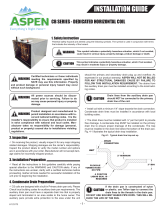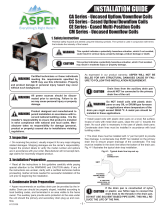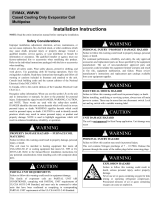
Installation Manual - CCG- VCG-MCG
INSTALLATION GUIDE
CCG Series - Uncased Upflow/Downflow Coils
VCG Series - Cased Upflow/Downflow Coils
MCG Series - Cased Multi-Position Coils
1. Safety Instruction
2. Inspection
3. Installation Preparation
4. Condensate Drain Preparation
!
WARNING
Potential safety hazards are alerted using the following symbols. The symbol is used in conjunction with terms
that indicate the intensity of the hazard.
This symbol indicates a potentially hazardous situation, which if not avoided,
could result in serious injury, property damage, product damage or death.
Certied technicians or those individuals
meeting the requirements specied by
NATE may use this information. Property
and product damage or personal injury hazard may occur
without such background.
Do NOT install coils with plastic drain
pans on any OIL or DRUM type furnaces
or applications where temperature of the
drain pan might exceed 260±5 ºF. A metal pan should be
installed in these applications.
This symbol indicates a potentially hazardous situation, which if not avoided,
may result in moderate injury or property damage.
Drain lines from the auxiliary drain pan
should NOT be connected to the primary
drain line of the coil.
If the drain pan is constructed of nylon
or plastic; use Teon tape to connect the
drain lines to the threads in the drain pan.
DO NOT USE SOLVENT BASED PIPE DOPE. THIS WILL RE-
DUCE THE LIFE OF THE PAN.
CAUTION
!
CAUTION
!
CAUTION
!
!
WARNING
!
WARNING
All power sources should be discon-
nected prior to servicing. Failure to do
so may cause personal injury or property
damage.
!
WARNING
Product designed and manufactured to
permit installation in accordance with lo-
cal and national building codes. It is the
installer’s responsibility to ensure that product is installed
in strict compliance with national and local codes. Man-
ufacturer takes no responsibility for damage (personal,
product or property) caused due to installations violating
regulations.
!
WARNING
ü On receiving the product, visually inspect it for any major shipping
related damages. Shipping damages are the carrier’s responsibility.
Inspect the product labels to verify the model number and options
are in accordance with your order. Manufacturer will not accept dam-
age claims for incorrectly shipped product.
ü Read all the instructions in this guideline carefully while paying
special attention to the WARNING and CAUTION alerts. If any of
the instructions are unclear, clarify with a certied technician before
proceeding. Gather all tools needed for successful installation of the
unit prior to beginning the installation.
ü
We recommend an auxiliary drain pan be provided by the in-
staller. Drain pan should be properly sloped, installed according to
local building codes, and terminated in an area visible to the home
owner. The auxiliary pans provide extra protection to the area under
the unit should the primary and secondary drain plug up and over-
ü Install cased coils with plastic drain pans on a level, at surface.
Incase of coils with metal drain pans, slope the coil ¼” towards the
drain. No such pitch is necessary in the case of plastic drain pans.
Condensate drain lines must be installed in accordance with local
building codes.
ü The drain lines must be installed with ¼” per foot pitch to provide
free drainage. A condensate trap MUST be installed on the primary
drain line to ensure proper drainage of the condensate. The trap
must be installed in the drain line below the bottom of the drain pan.
Fig. 4-1 illustrates the typical drain trap installation.
As expressed in our product warranty; WE WILL NOT BE
BILLED FOR ANY STRUCTURAL DAMAGES CAUSE BY FAIL-
URE TO FOLLOW THIS INSTALLATION REQUIREMENT.
Fig 4-1. Typical drain line trap set up
2











